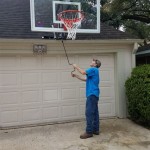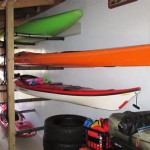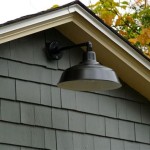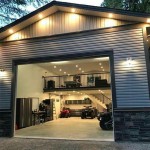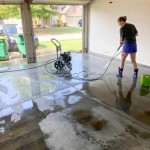Lighting Your Garage Right Now: A Comprehensive Guide
The garage, often relegated to a secondary space, frequently suffers from inadequate lighting. This deficiency hinders its utility, transforming it from a potential workspace, storage area, or hobby zone into a dimly lit, uninviting area. Addressing garage lighting is a relatively simple undertaking that yields significant improvements in functionality, safety, and overall usability of the space. This article provides a detailed guide to understanding and implementing effective garage lighting solutions.
Assessing Your Existing Garage Lighting and Needs
Before investing in new lighting fixtures, a thorough evaluation of the existing lighting situation is crucial. This assessment involves determining the current light output, identifying areas of insufficient illumination, and considering the primary uses of the garage. The goal is to understand the specific lighting needs of the space to select the most appropriate solutions.
Begin by noting the type and number of existing fixtures. Are they incandescent bulbs, fluorescent tubes, or perhaps earlier LED models? Each type has inherent advantages and disadvantages regarding energy efficiency, light quality, and lifespan. Incandescent bulbs, while inexpensive initially, are highly inefficient and produce significant heat. Fluorescent tubes offer better energy efficiency but can suffer from flickering and slow start-up times, especially in colder temperatures. Older LED fixtures might not provide the lumen output or color rendering index (CRI) of newer models. Analyze the current arrangement of fixtures to determine if the light is evenly distributed. Are there dark corners or areas where shadows are prevalent?
Consider the primary function of the garage. Is it primarily used for parking vehicles? Or is it also a workshop, storage area, or recreational space? A garage used solely for parking might require less intense, general lighting, while a workshop demands brighter, more focused illumination. If the garage includes a workbench, targeted task lighting will be essential. For storage areas, ensure that shelves and cabinets are adequately lit to easily identify and retrieve items.
Furthermore, consider any specific needs related to hobbies or activities performed in the garage. If woodworking or automotive repair are frequent activities, high-intensity lighting with excellent color rendering is crucial for detail work and safety. Take measurements of the garage's dimensions, including ceiling height. This information is necessary for calculating the required lumen output and selecting fixtures with appropriate mounting options.
Finally, account for any natural light sources, such as windows or skylights. Maximize their contribution to reduce reliance on artificial lighting during daylight hours. However, be mindful of glare and potential heat gain from sunlight. This initial assessment forms the foundation for a well-informed lighting upgrade.
Selecting the Right Lighting Fixtures
Once the existing lighting and needs are assessed, the selection process for new fixtures begins. A variety of options are available, each with its own characteristics and suitability for different garage environments. LEDs, fluorescent fixtures, and even high-intensity discharge (HID) lights can be considered, though LEDs are generally the preferred choice due to their efficiency, longevity, and performance.
LEDs (Light Emitting Diodes) offer significant advantages over traditional lighting technologies. They are exceptionally energy-efficient, consuming considerably less power than incandescent or fluorescent bulbs for the same light output. This translates to lower electricity bills and reduced environmental impact. LEDs also boast a remarkably long lifespan, often lasting tens of thousands of hours, minimizing the need for frequent replacements. Furthermore, LEDs offer instant-on illumination without flickering, and they are available in a wide range of color temperatures, allowing for customization of the light's ambiance. Look for fixtures with a high CRI (Color Rendering Index), ideally above 80, to ensure accurate color representation.
Fluorescent fixtures, particularly T5 and T8 tubes, remain a viable option for garage lighting. They are more energy-efficient than incandescent bulbs, although less so than LEDs. Fluorescent tubes provide a diffused, even light distribution, which can be beneficial for general illumination. However, they can be susceptible to temperature sensitivity, with reduced light output in cold environments. Older fluorescent fixtures may also exhibit flickering and contain small amounts of mercury, requiring careful disposal. Modern fluorescent fixtures with electronic ballasts minimize flickering and offer improved energy efficiency. When selecting fluorescent fixtures, consider those with a high lumen output and a color temperature appropriate for the intended use of the garage.
High-intensity discharge (HID) lights, such as metal halide and high-pressure sodium lamps, are typically used in large industrial settings due to their high lumen output. While they can provide ample light for a garage, they also consume a significant amount of energy and require a warm-up period before reaching full brightness. HID lights also tend to have a shorter lifespan than LEDs and may contain hazardous materials. Therefore, HID lighting is generally not recommended for residential garage applications, especially when energy-efficient and long-lasting LED alternatives are available.
When choosing lighting fixtures, consider the mounting options. Overhead fixtures are the most common, providing general illumination. These can be surface-mounted, suspended from the ceiling, or recessed. Task lighting, such as under-cabinet lights or clamp-on lamps, provides focused illumination for specific work areas. Motion-sensor lights can enhance security and energy efficiency by activating only when movement is detected.
Finally, pay attention to the IP (Ingress Protection) rating of the fixtures, especially if the garage is exposed to moisture or dust. A higher IP rating indicates better protection against these elements, ensuring the longevity and safe operation of the lighting.
Installation and Placement Strategies
Proper installation and strategic placement of lighting fixtures are essential for maximizing their effectiveness and ensuring safe operation. While some homeowners may be comfortable performing the installation themselves, it is often advisable to consult a qualified electrician, particularly when dealing with complex wiring or unfamiliar electrical systems.
Before starting any electrical work, always disconnect the power supply to the circuit at the breaker panel. Verify that the power is off using a non-contact voltage tester. Follow the manufacturer's instructions carefully when installing new fixtures. Ensure that all wiring connections are secure and properly insulated. Use wire connectors that are appropriate for the wire gauge and voltage. If replacing existing fixtures, take note of the wiring configuration before disconnecting the old fixture to ensure proper reconnection of the new one.
When positioning overhead fixtures, aim for even light distribution throughout the garage. This can be achieved by strategically placing fixtures to minimize shadows and dark spots. Consider the layout of the garage and the placement of shelves, cabinets, and workbenches. Position fixtures to provide ample light in these areas. For single-car garages, a central fixture may suffice, but larger garages will require multiple fixtures to achieve adequate illumination. Spacing the fixtures evenly across the ceiling will generally provide the most uniform light distribution.
Task lighting is crucial for work areas, such as workbenches and tool storage spaces. Under-cabinet lights are an excellent option for illuminating countertops and providing focused light for detail work. Clamp-on lamps or adjustable spotlights can be used to direct light precisely where it is needed. Ensure that task lighting is positioned to minimize glare and shadows, which can hinder visibility and increase eye strain.
Consider installing motion-sensor lights near entry points to enhance security and energy efficiency. These lights automatically activate when movement is detected, providing illumination for entering and exiting the garage. They also serve as a deterrent to potential intruders. Adjust the sensitivity and duration settings of the motion sensors to optimize performance and prevent unnecessary activation.
For garages with high ceilings, consider using pendant lights or suspended fixtures to bring the light closer to the work surface. This can improve illumination and reduce shadows. Ensure that the hanging height of the fixtures is appropriate for the ceiling height and the intended use of the space. Avoid positioning fixtures where they could be easily damaged by vehicles or other objects.
After installation, test all fixtures to ensure they are functioning correctly. Verify that the light output is sufficient for the intended use of the garage. If necessary, adjust the positioning or add additional fixtures to achieve optimal illumination. Regularly clean the fixtures to maintain their brightness and prevent dust buildup, which can reduce light output.

Brighten Up Your Garage

Best Garage Lighting Upgrade Under 100 Brighten Your Space Now

Cleveland Garage Lighting Interior Led Lights

Choosing The Best Led Light For Your Garage

Shed Lighting Matters Plan Now So You Re Not In The Dark Steel Sheds

Led Garage Lights 60w Trilights Ceiling High Low Bay Deformable Adjustable 4 Light Bulbs In Tribright Lighting Fixture For

Bell Howell Triburst Light 360 Led Bulb Lights Garage Ceiling Work 4000 Lumens 3 Brightness Modes Adjustable

Pick The Right Lighting To Brighten Every Home Space

2 Pack Bell Howell Triburst Garage Lights 288 Led Bulb 4000 Lumens Ceiling Socket Deformable Light

Our Custom Addressable Led Install For Adrianportelli In What Is Now The Hottest Garage Melbourne Dm Us Lights Like These On Your Next Project Ledlights Addressableledstrip Ledstrip
Related Posts

